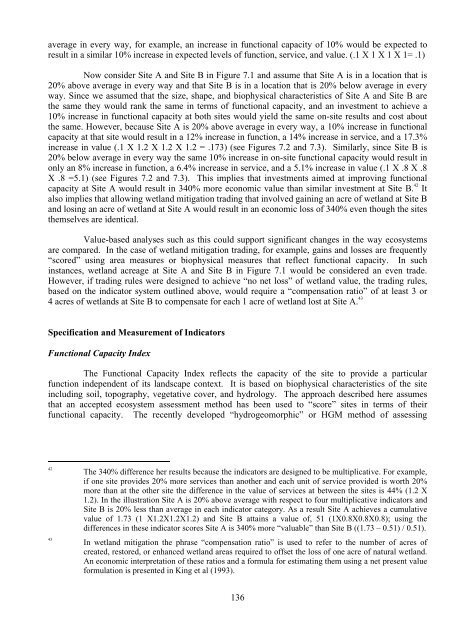average in every way, for example, an increase in functional capacity <strong>of</strong> 10% would be expected toresult in a similar 10% increase in expected levels <strong>of</strong> function, service, and value. (.1 X 1 X 1 X 1= .1)Now consider Site A and Site B in Figure 7.1 and assume that Site A is in a location that is20% above average in every way and that Site B is in a location that is 20% below average in everyway. Since we assumed that the size, shape, and biophysical characteristics <strong>of</strong> Site A and Site B arethe same they would rank the same in terms <strong>of</strong> functional capacity, and an investment to achieve a10% increase in functional capacity at both sites would yield the same on-site results and cost aboutthe same. However, because Site A is 20% above average in every way, a 10% increase in functionalcapacity at that site would result in a 12% increase in function, a 14% increase in service, and a 17.3%increase in value (.1 X 1.2 X 1.2 X 1.2 = .173) (see Figures 7.2 and 7.3). Similarly, since Site B is20% below average in every way the same 10% increase in on-site functional capacity would result inonly an 8% increase in function, a 6.4% increase in service, and a 5.1% increase in value (.1 X .8 X .8X .8 =5.1) (see Figures 7.2 and 7.3). This implies that investments aimed at improving functionalcapacity at Site A would result in 340% more economic value than similar investment at Site B. 42 Italso implies that allowing wetland mitigation trading that involved gaining an acre <strong>of</strong> wetland at Site Band losing an acre <strong>of</strong> wetland at Site A would result in an economic loss <strong>of</strong> 340% even though the sitesthemselves are identical.Value-based analyses such as this could support significant changes in the way ecosystemsare compared. In the case <strong>of</strong> wetland mitigation trading, for example, gains and losses are frequently“scored” using area measures or biophysical measures that reflect functional capacity. In suchinstances, wetland acreage at Site A and Site B in Figure 7.1 would be considered an even trade.However, if trading rules were designed to achieve “no net loss” <strong>of</strong> wetland value, the trading rules,based on the indicator system outlined above, would require a “compensation ratio” <strong>of</strong> at least 3 or4 acres <strong>of</strong> wetlands at Site B to compensate for each 1 acre <strong>of</strong> wetland lost at Site A. 43Specification and Measurement <strong>of</strong> IndicatorsFunctional Capacity IndexThe Functional Capacity Index reflects the capacity <strong>of</strong> the site to provide a particularfunction independent <strong>of</strong> its landscape context. It is based on biophysical characteristics <strong>of</strong> the siteincluding soil, topography, vegetative cover, and hydrology. The approach described here assumesthat an accepted ecosystem assessment method has been used to “score” sites in terms <strong>of</strong> theirfunctional capacity. The recently developed “hydrogeomorphic” or HGM method <strong>of</strong> assessing4243The 340% difference her results because the indicators are designed to be multiplicative. For example,if one site provides 20% more services than another and each unit <strong>of</strong> service provided is worth 20%more than at the other site the difference in the value <strong>of</strong> services at between the sites is 44% (1.2 X1.2). In the illustration Site A is 20% above average with respect to four multiplicative indicators andSite B is 20% less than average in each indicator category. As a result Site A achieves a cumulativevalue <strong>of</strong> 1.73 (1 X1.2X1.2X1.2) and Site B attains a value <strong>of</strong>, 51 (1X0.8X0.8X0.8); using thedifferences in these indicator scores Site A is 340% more “valuable” than Site B ((1.73 – 0.51) / 0.51).In wetland mitigation the phrase “compensation ratio” is used to refer to the number <strong>of</strong> acres <strong>of</strong>created, restored, or enhanced wetland areas required to <strong>of</strong>fset the loss <strong>of</strong> one acre <strong>of</strong> natural wetland.An economic interpretation <strong>of</strong> these ratios and a formula for estimating them using a net present valueformulation is presented in King et al (1993).136
wetlands, for example, results in Functional Capacity Indicators (FCIs) for around ten wetlandfunctions from sediment and nutrient trapping to waterfowl habitat. 44Figure 7.2 Illustration <strong>of</strong> Indicator Development for Site A and Site BPrototype indicatorsEach site is ranked for each <strong>of</strong> three wetland functions using four sub-indices that range from 0 to 2around an “average” value <strong>of</strong> 1. For a site that is average in every way, an x% change in functional capacityis expected to result in an x% change in functions, services and values.Site A and Site B have the same functional capacity. However, the landscape context <strong>of</strong> Site A isabove average in every way and the landscape context <strong>of</strong> Site B is below average in every way. In thisillustration, Site A is assumed to be 20% above average (Indices <strong>of</strong> 1.2 in all categories) and Site B isassumed to be 20% below average (Indices <strong>of</strong> 0.8 in all categories).Relative value <strong>of</strong> Site A and Site BWildlife habitat Fishery support Nutrient trappingSite A Site B Site A Site B Site A Site BFunctionalCapacityIndexCapacityUtilisationSub-indexServiceCapacitySub-indexValue OfServiceSub-indexRisk OfServiceSub-indexIdentical size,shape,bio-physicalcharacteristicsScore: 1.0Wildlife Corridoropen from NorthScore: 1.2Near residentialareas,accessible, publiclandScore: 1.2Accessible toresidentialpopulationScore 1.2Ag land in agpreservationdistrict (corridorremains open)Score 1.2Identical size,shape,bio-physicalcharacteristicsScore: 1.0Wildlife Corridorblocked fromNorth byHighway 66Score: 0.8Surrounded byindustrial sites,inaccessible,private landScore: 0.8Access limited t<strong>of</strong>ew richScore: 0.8Forest zoned fordevelopment(habitat likely todecrease)Score 0.8Identical size,shape,bio-physicalcharacteristicsScore: 1.0Traps agriculturalsediment, nearcoast, adjacent t<strong>of</strong>ishing groundsScore: 1.2Adjacent to largehealthy shellfisharea, publicaccess, nearbyparkingScore: 1.2Aestheticrecreationalopportunities formany poorScore: 1.2Local area is builtout – no newsources <strong>of</strong>sedimentScore 1.2Identical size,shape,bio-physicalcharacteristicsScore: 1.0Identical size,shape,bio-physicalcharacteristicsScore: 1.0Little sediment to Upslope is farmtrap, <strong>of</strong>f the land generatingcoast, adjacent to nutrient flow,boat channelScore: 0.8Few shellfishnearby, littleaccess if therewere, near pointsource dischargeScore 0.8Access limited t<strong>of</strong>ew richScore: 0.8Any futuredevelopment willgenerate moresediments(developedreplaces forest)Score 0.8natural waterflow, non-pointdischargeScore: 1.2Adjacent to largehealthy shellfisharea, publicaccess, nearbyparkingScore: 1.2General waterqualityimprovements,and adjacent tohealthy shellfisharea, accessibleto poorScore: 1.2Newdevelopmentupstream wouldbe on sewerScore 1.2Identical size,shape, bio-physicalcharacteristicsScore: 1.0Upslope isindustrial sites andforests (littlenutrients)channelized waterflow to pointdischarge Score:0.8Few shellfishnearby, little accessif there were, nearpoint sourcedischargeScore 0.8General waterqualityimprovements onlyScore: 0.8Futuredevelopment onsepticScore 0.844The “hydrogeomorphic” or HGM wetland assessment method results in wetland functional capacityindicators that take very little account <strong>of</strong> landscape context in determining expected levels <strong>of</strong> wetlandfunction, and no account <strong>of</strong> how landscape context affects wetland services and values. The authorsare involved in research to extend the HGM method using many <strong>of</strong> the concepts and applicationsdescribed in this paper. We are estimating prototype indicators to assess gains and losses associatedwith actual wetland mitigation trades in the state <strong>of</strong> Florida.137
- Page 1 and 2:
«ENVIRONMENTValuation ofBiodiversi
- Page 3 and 4:
ORGANISATION FOR ECONOMIC CO-OPERAT
- Page 5 and 6:
TABLE OF CONTENTSPART 1 ...........
- Page 7 and 8:
PART 4 ............................
- Page 10 and 11:
Why value biodiversity?There are th
- Page 12 and 13:
Figure 1.1 Total economic value: us
- Page 14 and 15:
from biodiversity at the local leve
- Page 16 and 17:
in the database and also for undert
- Page 18 and 19:
in the policy context. This is high
- Page 20:
Table 1.3 Policy Options for the Cl
- Page 23 and 24:
Box 1.2 Value of Turkey’s Forests
- Page 25 and 26:
of the most important implications
- Page 27 and 28:
Additionally, valuation does not ju
- Page 29 and 30:
value is the habitat, many differen
- Page 31 and 32:
are very modest. More recently, new
- Page 33 and 34:
Table 2.2 Estimates of the Medicina
- Page 35 and 36:
The importance of indirect use valu
- Page 37 and 38:
pharmaceutical use, although the li
- Page 39 and 40:
McAllister, D., (1991). Estimating
- Page 41 and 42:
Simpson, D and Craft, A.. (1996).
- Page 43 and 44:
practice, the overlap between these
- Page 45 and 46:
aimed at giving more precise quanti
- Page 47 and 48:
structural values. There are a numb
- Page 49 and 50:
Reid (forthcoming) discusses the po
- Page 51 and 52:
Ecotourism as a Way to Generate Loc
- Page 53 and 54:
endangered Indian rhino and other t
- Page 55 and 56:
ReferencesBann, C., and M. Clemens
- Page 57 and 58:
PART 261
- Page 59 and 60:
many European countries, CBA has a
- Page 61 and 62:
(1) Cost and time constraintsThe co
- Page 63 and 64:
activity day, there is greater vari
- Page 65 and 66:
added independent variable C s= cha
- Page 67 and 68:
error in valuing respiratory sympto
- Page 69 and 70:
ReferencesArrow, K.J., R. Solow, E.
- Page 71 and 72:
OECD (1995). The Economic Appraisal
- Page 73 and 74:
CHAPTER 5:by José Manuel LIMA E SA
- Page 75 and 76:
linkages usually lead to diverse co
- Page 77 and 78: A discrete choice approach to quest
- Page 79 and 80: Table 5.2 Model-based point estimat
- Page 81 and 82: is potentially very large for multi
- Page 83 and 84: P3 is already in the mix is 2.51, s
- Page 85 and 86: PART 391
- Page 87 and 88: measures of value. An appendix to t
- Page 89 and 90: features (such as parks, beaches or
- Page 91 and 92: included in cost-benefit analysis o
- Page 93 and 94: A Discussion of Past Efforts to Dev
- Page 95 and 96: Satellite AccountsIn addition to th
- Page 97 and 98: which many people argue are associa
- Page 99 and 100: approach to competing uses of water
- Page 101 and 102: Figure 6.2 Trade-Off AnalysisEnviro
- Page 103 and 104: However, the farmers need not bear
- Page 105 and 106: Appendix 1: Theory and Application
- Page 107 and 108: iwhere C is the income adjustment n
- Page 109 and 110: complete. If there are more than on
- Page 111 and 112: Horowitz, Joel. L. and Jordan. J. L
- Page 113 and 114: CHAPTER 7:by Dennis M. KING and Lis
- Page 115 and 116: Box 7.1 Definition of terms related
- Page 117 and 118: Box 7.2 Categories of Ecosystem Ser
- Page 119 and 120: Box 7.4 Dollar-based ecosystem valu
- Page 121 and 122: Non-monetary indicators of ecosyste
- Page 123 and 124: Figure 7.1 Effects of Wetland Locat
- Page 125 and 126: description, and that the usefulnes
- Page 127: 2) Service capacity sub-indexIndica
- Page 131 and 132: (1) Functional CapacityIndexFigure
- Page 133 and 134: constituents of runoff can be predi
- Page 135 and 136: Service(on or off site)Recreational
- Page 137 and 138: Table 7.3 Service Risk Sub-index De
- Page 139 and 140: Measuring Service Preference Weight
- Page 141 and 142: Table 7.4 Illustration of Paired Co
- Page 143 and 144: PART 4151
- Page 145 and 146: Ecological foundations for biodiver
- Page 147 and 148: Phenotic diversity is a measure bas
- Page 149 and 150: Operationalisation of the biotic-ri
- Page 151 and 152: ten attributes that could score a m
- Page 153 and 154: The choice of the scale relates to
- Page 155 and 156: Nature measurement methodIn 1995, t
- Page 157 and 158: Table 8.4 Value orientations and en
- Page 159 and 160: Table 8.5 Identification of monetar
- Page 161 and 162: Table 8.6 Valuation studiesSingle s
- Page 163 and 164: in waterway systems for nine impact
- Page 165 and 166: to other contexts, conditions, loca
- Page 167 and 168: ReferencesAkcakaya, H.R. (1994).
- Page 169 and 170: de Groot, R.S. (1994). “Environme
- Page 171 and 172: Mace, G. M. & S. N. Stuart. (1994).
- Page 173 and 174: Turner, R.K., Perrings, C. and Folk
- Page 175 and 176: John A. DixonJohn A. Dixon is Lead
- Page 177 and 178: Robert O’NeillDr. O’Neill recei
- Page 179 and 180:
Steven StewartSteven Stewart is Ass
- Page 181:
OECD PUBLICATIONS, 2, rue André-Pa












